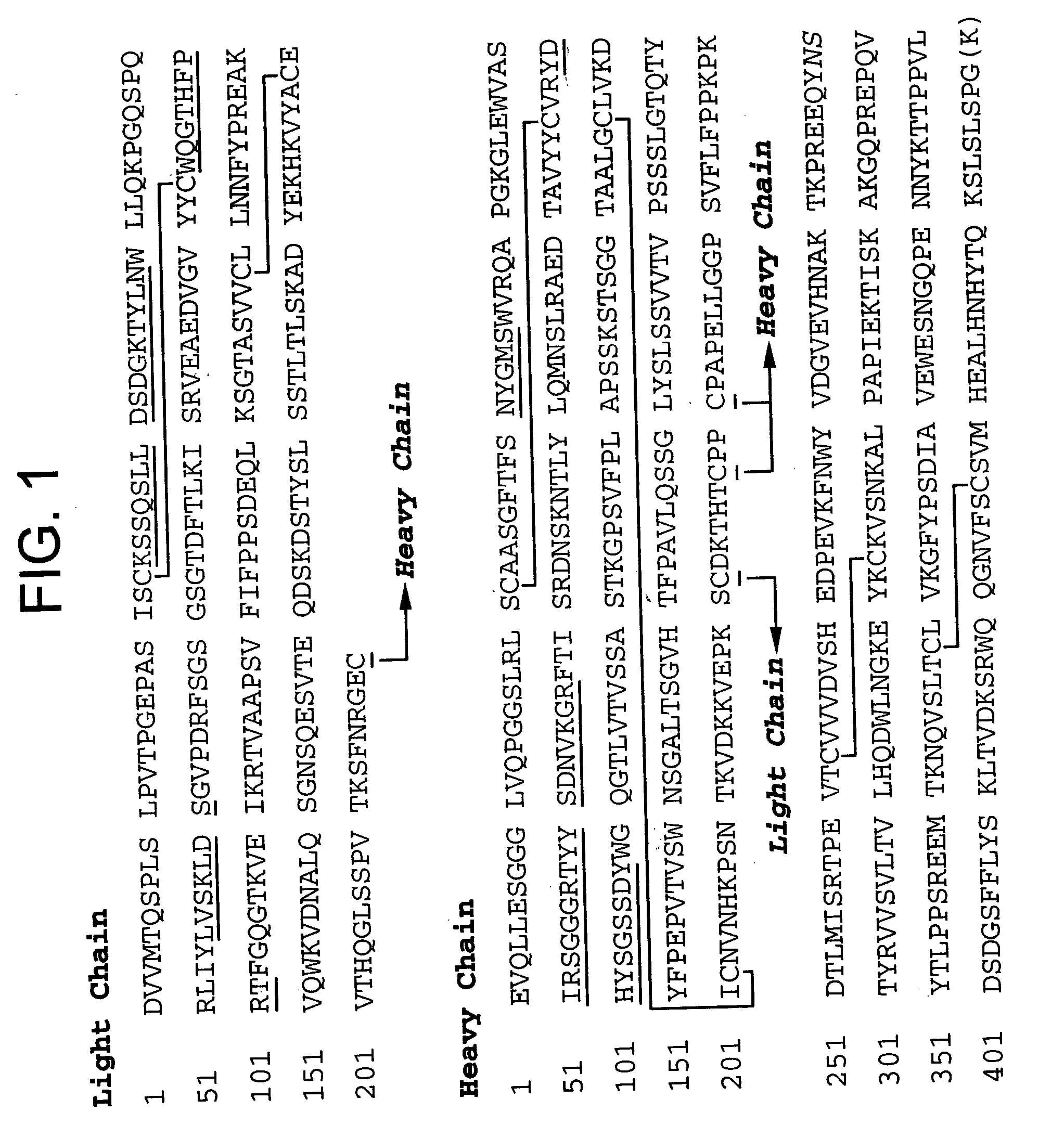Methods of purifying anti a beta antibodies
a technology of beta antibodies and purification methods, which is applied in the field of purification methods of anti beta antibodies, can solve the problems of insufficient purity for use in research or as therapeutics, limited schemes, and high undesirable impurities, and achieve the effect of reducing the levels of one or more intron read-through variant species and reducing the levels of on
- Summary
- Abstract
- Description
- Claims
- Application Information
AI Technical Summary
Benefits of technology
Problems solved by technology
Method used
Image
Examples
example 1
Comparison of Wash Buffers for IRT Removal
[0180] In this example, an impure solution containing the anti-Aβ monoclonal antibody AAB was purified by adsorption onto a Protein A column followed by a first wash with a wash buffer containing either CaCl2, MgCl2, NaCl or propylene glycol.
[0181] The culture containing the monoclonal antibody was purified at small scale using an rmp Protein A Sepharose™ FF column (8.9 mL) connected to a GE Healthcare ÄKTA FPLC chromatography system. For all the rmp Protein A Sepharose™ FF chromatography steps described in experiment 1, the following conditions were used. (Exceptions are noted in the individual experimental descriptions). [0182] Column dimensions—1.0 cm×11.4 cm [0183] Operational flow rate—150 cm / hr [0184] Equilibration 1—20 mM Tris, 150 mM NaCl, pH 7.5 (5 column volumes) [0185] Flush—20 mM Tris, 150 mM NaCl, pH 7.5 (1 column volume) [0186] Wash 1—Variable (See Table 2) except for run #1, which had no wash 1 [0187] Wash 2—20 mM Tris, 1.0 ...
example 2
Protein A Chromatography with CaCl2 Wash for IRT Removal
[0197] In this example, a larger scale antibody purification was carried out using Protein A chromatography with a CaCl2 wash to remove IRT species.
[0198] The culture containing the monoclonal antibody was purified at pilot scale using a MabSelect Protein A column (2.4 L) connected to a Millipore K-Prime 400 chromatography system. The two MabSelect runs were performed as described below. [0199] Column dimensions—13 cm×18 cm [0200] Operational flow rate—150 cm / hr, 300 cm / hr [0201] Equilibration 1—20 mM Tris, 150 mM NaCl, pH 7.5 (5 column volumes) [0202] Flush—20 mM Tris, 150 mM NaCl, pH 7.5 (2 column volumes) [0203] Wash 1—50 mM Tris, 2 M CaCl2, pH 7.5 for run #1 and no wash 1 for run #2 [0204] Wash 2—20 mM Tris, 1.0 M NaCl, pH 7.5 (5 column volumes) [0205] Wash 3—10 mM Tris, 75 mM NaCl, pH 7.5 (5 column volumes) [0206] Elution—50 mM Glycine, 25 mM NaCl, pH 3.1 (6 column volumes) [0207] Strip 1—50 mM Glycine, 0.5 M NaCl, pH 2....
example 3
DNA Removal
[0214] In this example, the ability of a CaCl2 wash to remove host cell DNA from a preparation containing the AB monoclonal antibody was examined.
[0215] The culture containing the monoclonal antibody was purified at small scale using a MabSelect Protein A column (19 mL) connected to a GE Healthcare ÄKTA FPLC chromatography system. The three MabSelect runs were performed as described below. [0216] Column dimensions—1.1 cm×20 cm [0217] Operational flow rate—300 cm / hr [0218] Equilibration 1—20 mM Tris, 150 mM NaCl, pH 7.5 (5 column volumes) [0219] Flush—20 mM Tris, 150 mM NaCl, pH 7.5 (2 column volumes) [0220] Wash 1—50 mM Tris, 2.0 M CaCl2, pH 7.5 (5 column volumes) (Runs 2 and 3 only) [0221] Wash 2—20 mM Tris, 1.0 M NaCl, pH 7.5 (5 column volumes) (Runs 1 and 3 only) [0222] Wash 3—10 mM Tris, 75 mM NaCl, pH 7.5 (7 column volumes) [0223] Elution—50 mM Glycine, 75 mM NaCl, pH 3.0 (6 column volumes) [0224] Strip—50 mM Glycine, 0.5 M NaCl, pH 2.7 (5 column volumes) [0225] St...
PUM
| Property | Measurement | Unit |
|---|---|---|
| temperature | aaaaa | aaaaa |
| pH | aaaaa | aaaaa |
| pH | aaaaa | aaaaa |
Abstract
Description
Claims
Application Information
 Login to View More
Login to View More - R&D
- Intellectual Property
- Life Sciences
- Materials
- Tech Scout
- Unparalleled Data Quality
- Higher Quality Content
- 60% Fewer Hallucinations
Browse by: Latest US Patents, China's latest patents, Technical Efficacy Thesaurus, Application Domain, Technology Topic, Popular Technical Reports.
© 2025 PatSnap. All rights reserved.Legal|Privacy policy|Modern Slavery Act Transparency Statement|Sitemap|About US| Contact US: help@patsnap.com

